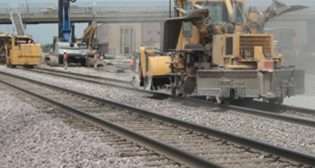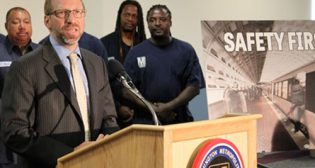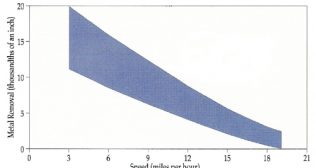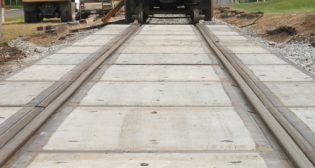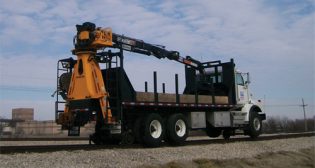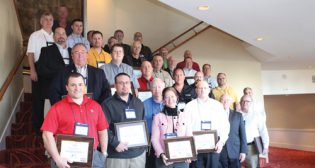Suppliers are improving wheel/rail lubrication programs with new formulations and improved modes to deliver friction modifiers on the rails for a smooth ride.
Wheel/rail friction modifiers have been updated and reformulated to become environmentally friendly, which was just one focus for suppliers in the past year. Additionally, it’s not only what you put on the rails, but how. Suppliers are upping the ante and producing the most technologically advanced systems to get the job done right without wastefullness and at a attractive price point.
ELM
“Environmental Lubricants Manufacturing, Inc., is the only company in the U.S. that manufactures exclusively biobased greases and lubricants for railroad friction management,” notes Lou Honary, chairman and president of ELM. “The company incorporates a revolutionary manufacturing process that utilizes microwaves for the reaction process of making grease. This process does not damage the vegetable oils during the high-temperature reaction process and as a result, a more oxidatively stable and economical biodegradable grease is produced.”
Honary says he sees the railroads spending much more on friction reduction through lubrication in 2012 because it makes economic sense. Friction reduction improves fuel economy and as the cost of fuel goes up, the cost of lubrication can easily be justified, he notes.
“I believe the increased use of biofuels and the awareness it has created within the railroad industry will be helpful in promotion and use of biobased greases and switch lubricants, etc.”

ELM biobased grease being tested.
L.B. Foster
“The company has remained at the forefront of technological development with a steady stream of technical advances that enhance the efficiency and effectiveness of friction control programs since L.B. Foster acquired Portec Rail Products, Inc., in late 2010,” said Dr. Kevin Oldknow, vice president technology and business development, friction management at L.B. Foster Company.
Friction management, including both gauge-face lubrication and top-of-rail friction control, remains a fast evolving field. According to Oldknow, one of the most significant advances that has been made in top-of-rial friction modifier technology since its introduction more than a decade ago has been the development and implementation of KELTRACK® ER (Enhanced Retentivity).
A number of chemistry packages comprise thin film friction modifiers, each delivering one or more key components of the overall material behavior. The term “Enhanced Retentivity” refers to a complete revision of KELTRACK’s film forming chemistry, providing improvement in the resistance to cyclic wheel/rail compressive loads. This is said to yield a dramatic reduction in the quantity of friction modifier needed to establish TOR friction control over a given territory.
“As with any material destined for use at the TOR/wheel tread interface, KELTRACK ER was required to undergo exhaustive testing over several years to ensure that neither performance nor safety were compromised,” explained Oldknow. “As the industry’s only true friction modifier technology (delivering an intermediate coefficient of friction and positive friction-creepage characteristics through a dry, thin film), the KELTRACK family of products establishes dry thin film friction control that delivers reductions in lateral loads and lateral/vertical ratios, rail and wheel wear, locomotive diesel usage, rolling contact fatigue development, curving noise and corrugations. In the past year, Enhanced Retentivity technology has become fully commercialized and is in territory-wide usage under a range of operating conditions including severe curvatures, curve densities and gradients.”
Oldknow notes a lingering question in the industry has been “how do we know that our friction control program is working?” He says L.B. Foster has provided a definitive answer to this question through a cooperative project between the company’s friction management and Salient Systems product teams. Its lateral/vertical force measurement Module is specifically designed to integrate with the Remote Performance Monitoring™ (RPM™) technology, providing a cost effective way to monitor L/V force levels at multiple locations throughout a given territory. These results are then integrated into a web interface used to monitor PROTECTOR® wayside friction control system performance. This information verifies the effectiveness of KELTRACK TOR friction control monitored in near-real time over complete territories.
Moving from trackside systems to train-mounted equipment, the company’s AutoPilot™ system has also seen major technical advances in the past year. Improvements include a full-featured telemetry system fully integrated with the RPM framework, providing a clean and effective web interface. The system has been made more robust with nozzle and fluid delivery system improvements to handle an even wider range of operating conditions in the harsh and rugged heavy haul operating world.
“The economic case for friction management has gained very secure footing, helping to justify continued investment in these technologies,” explained Oldknow. “Multiple Class 1 railroads have published rigorous scientific data from collaborative projects demonstrating the effectiveness of KELTRACK TOR friction control in generating rail and fuel savings and several other meaningful economic benefits. When combined with optimized state-of-the-art GF lubrication using PROTECTOR trackside systems and premium greases with targeted extreme pressure additive packages, dedicated and effective management and maintenance and filling programs, the net benefits to the global rail industry are highly compelling.”
Oldknow says the L.B. Foster team is working on a major set of product improvements set for release during the 2012 calendar year.

L.B. Foster using the LVM to measure L/V force levels.
Lincoln
“As a world leader in manufacturing lubrication products, Lincoln has more than 100 years of expertise,” said Pete Laucis, global director product management at Lincoln Industrial. “That knowledge and experience will continue to benefit the rail industry during 2012. With its diverse lubrication market experience, Lincoln is better positioned to respond to rail customers and develop new products, systems and solutions based on customer requirements.”
Lincoln recently developed the digital controller. Introduced to expand the capabilities of controlling the grease distribution to the rail, the new controller is said to be user-friendly, due to the soft keypad, which makes it easy to navigate through the controller parameters. The Lincoln digital controller is capable of counting up to 128 axles, an increase from 32 with the previous controller. Coupled with the ability to specify the pump on time with a range of two-14 seconds, the volume of grease distribution can be dialed in to satisfy the demand.
“The controller also has the capability to provide different volumes of grease in either direction of train travel,” said Laucis. “For example, if there are numerous curves in one direction, but only a few in the other, grease distribution can be proportioned for both directions to minimize excess usage.”
The digital controller is said to accurately keep track of the cumulative total volume of grease that has been dispensed to the rail by using a proximity switch on the patented dispensing bar’s Pump-To-Port® metering valve. Weather-related features include a thermostat when a water-based friction modifier is used along with a rain/snow sensor capability.
The controller also has been improved cosmetically with a waterproof enclosure and an accessible terminal strip inside for easy electrical hookups, notes Laucis.
Lincoln has refined its gauge face bars going to a metal-to-metal seal, speeding installation and reducing maintenance.
Other products of Lincoln’s include its durable 200-pound reservoir, which provides a compact, turnkey package for customers dealing with space constraints. The weather-resistant, powder-coated steel reservoir contains all of the same pumps and controls as Lincoln’s 800-pound unit.
The company’s 600 mm gauge face short bars have the ability to lubricate closer to or in the spiral of a curve.
Lincoln’s pecial systems for metro/transit applications provide unlimited tank customization for unique applications.
The company notes its Next Generation gauge face dispensing bar takes precision lubrication placement to another level.
Lincoln offers clients installation accessories, including a variety of items designed to reduce maintenance time.
Additionally, Lincoln still offers electronic interfaces with user-specific communication platforms. These electronic interfaces are universally compatible with known telemetric systems.
Lincoln continues to work with Class 1 and Class 2 railroads, along with the metro/transit market to analyze cost-saving areas by employing improved lubrication methods.
“We expect to see increased emphasis on more compact and modular products for noise abatement applications in the metro/transit market,” added Laucis.

Lincoln Industrial’s top-of-rail system on the Florida East Coast Railway.
Terresolve
Terresolve Technologies, Ltd., says it is dedicated to providing non-toxic, biodegradable lubricating products that deliver exceptional performance. Mark Miller, CEO of Terresolve notes that Terresolve’s biobased and biodegradable fluids have been extensively proven in the lab and in the field and are renewable, support the agrarian community and meet federal guidelines for environmentally preferable purchasing.
Terresolve recently introduced EnviroLogic 801LCG, a biodegradable rail curve grease. EL 801LCG is said to have excellent cold temperature characteristics versus other competitive products and a unique thickener/tackifier formula that improves tenacity of the product to the rails.
The company also manufactures biodegradable hydraulic fluids for track maintenance equipment.
“These products outperform petroleum oils and in the event of a leak or spill, have no long-term effect on the environment,” explained Miller. “These products not only protect railroad equipment, but also protect the railroad contractor while he is working in environmentally sensitive projects, especially over water, in the event of a spill.”
Terresolve sees not only an overall increase in the rail lubrication programs in 2012, but especially in programs using and requiring biodegradable, high-performance lubricants and greases.
Terresolve currently supplies bio hydraulic fluids to a Class 1 railroad for track maintenance equipment.
“We are excited about the recent launch of the new bio curve grease and have begun to secure business with our current customers, as well as potential clients,” said Miller.

Terresolve’s lubrication products.
Tranergy, powered by LORAM
Tranergy Inc., powerd by LORAM, is currently working on a new and improved friction modification delivery system.
“This system has a finer resolution than the previous method,” explained Jon Behrens, integration manager at Tranergy Inc., powered by LORAM. “This finer resolution will reduce friction modifier waste during rail application by applying precisely the right amount of friction modifier in the ideal position on the top of the rail, allowing the train wheels to distribute the FM more effectively.”
The new system is said to be flexible enough to work with a variety of friction modifiers of different viscosities and at a large temperature range. This flexibility gives the customer more options on unit placement.
Tranergy has experienced an increased demand from its customers for friction management programs, notes Behrens. He says railroads are realizing the benefits of friction modification, including less energy consumption, reduced lateral forces and reduced rail damage.
Many railroads are establishing departments within their organizations to manage rail lubrication, similar to other maintenance-of-way departments such as rail grinding, notes Behrens.
“The implementation of a rail lubrication group within a railroad’s organization helps ensure consistency in the type of friction modifier products used on the railroad and efficiency of the FM delivery and maintenance schedules,” explained Behrens. “Sometimes railroads do not place enough value on the maintenance of the friction modification units.
“This issue varies between divisions and subdivisions of a railroad. It’s important that all railroad personnel are educated on the benefits and applications of friction modification and remain consistent in the use of the products. This understanding then leads the roadmasters to manage the maintenance of these units to ensure proper functionality.”
Tranergy, in partnership with Loram Maintenance of Way, Inc., is currently pursuing opportunities on heavy haul railroads in North America and abroad to offer enhanced top-of-rail friction management products and services.

Tranergy, powered by LORAM’s friction modifier system.
Whitmore’s
“Whitmore’s has been and will continue to be a market leader in rail lubrication,” noted Bruce Wise, director of railroad sales at Whitmore’s. “Our R&D and QC efforts are continuous and aided by the fact that we design and manufacture all of our products at our facility in Rockwall, Texas.”
He says 2012 will be an exciting year for Whitmore’s and one where its product offering will expand and core products will be enhanced.
Rail and wheel friction management continues to be an important initiative for the worldwide customer base of Whitmore’s, explains Wise.
“Our input would suggest that most railroads will maintain their current programs and expand them in areas where traffic levels and tonnage are increasing.”

ELM’s variety of greases.
